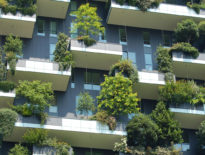Beavers, bees, bears, eagles, ants, termites, spiders, rabbits, snakes, coral, and a vast range of other animals build homes for themselves and their progeny. These shelters often have profound effects on the surrounding environment.

Humans, however, are in a whole different league. The human ability to create shelters has permitted our species to extend its range from the Arctic to the Sahara, from Manaus to Minneapolis. The resulting spread of humanity across the surface of the earth has become, in recent decades, a vast, sometimes-irreversible experiment to test the viability of the planet under stress.
Other than the cyanobacteria that introduced free oxygen into the atmosphere some 2.5 billion years ago, no other creature has ever had such a profound influence on the world. Humans have changed the climate, acidified the oceans, launched an epidemic of extinction, and created radioactive wastes that will remain dangerous for longer into the future than Homo sapiens has existed.
Frighteningly often, we don’t know what we are doing. The CFCs that widely served as refrigerants for air conditioners, propellants in spray cans, and fire extinguishers were thought for decades to be an utterly benign, utilitarian triumph of industrial chemistry. Only in the early 1970s did Sherwood Rowland and Mario Molina discover that CFCs were principally responsible for the destruction of the stratospheric ozone layer. This “triumph of modern chemistry” turned out to be such a major threat to life on the planet that the chemicals had to be outlawed globally.
When seven billion humans do something, it is by definition big. So it is with buildings. In 2014, China produced 2.7 billion tons of cement. The manufacture of one ton of cement produces early one ton of carbon dioxide. Cement — used in essentially all our buildings and foundations —accounts for about 5 percent of all anthropogenic CO2 released each year.
Wood could be a less destructive, more sustainable building material than cement. Forests can capture atmospheric carbon, protect topsoil from erosion, and provide habitat for a rich variety of species (including the last 450 wild Siberian tigers). But voracious logging companies have for the last century been harvesting the world’s old growth boreal forests and fragile rainforests with no more care and selectivity than a combine brings to a North Dakota wheat crop. Although such ecological pillaging is illegal in most of the world’s forests, the governments of wood-exporting states are often too poor or too corrupt to enforce the law. Importing countries turn a blind eye in return for rock bottom prices. The environmental impacts of the built environment are enormous, and they reach far beyond the local sites of our buildings, neighborhoods, and cities.
In the late 20th century, a variety of efforts were undertaken to encourage more sustainable buildings. There are now approximately 600 building certification programs in effect globally — some serving neighborhoods and others spanning continents. Many, like the Forest Stewardship Council, Energy Star, and Water Sense focus on a single attribute of buildings. Others, like Passivhaus, the USGBC’s LEED standards, Green Seal, BREAM, Cradle to Cradle, Pharos, CASBEE, Green Mark, Green Star and Pearl review multiple aspects of buildings or building materials. Such programs represent steps in the right direction. But they all tend to focus mostly on the construction of a building, not its subsequent performance.
From the developer’s viewpoint, that is very attractive. A developer who is willing to spend the money to incorporate the required features can guarantee the building’s rating. Developers treasure such certainty.
From society’s viewpoint, however, this approach has a major fault. The actual performance of buildings sometimes does not correlate with the sum of its features. Many LEED Silver buildings, for example, have better real-world performance than LEED Platinum buildings. These lower-rated buildings often have superior design and better construction, but they contain fewer of the attributes that are awarded “points.”
I am a strong supporter of green certification. LEED, in particular, has had an enormous impact in nudging architects, developers, and banks in a greener direction. Even the most basic LEED standards have created a demand for smarter designs, more efficient equipment, and better materials. The growing consumer demand for LEED Platinum, Passivhaus, Cradle-to-Cradle, and others has led to very significant innovations.

But for those of us who seek a deeply transformational approach to buildings — one measured by long-term performance — the Living Building Challenge filled a void. The Living Building Challenge re-conceptualizes buildings as organisms, nested within an urban ecosystem that reflects the climate and the geophysics of its immediate environment. The Challenge is based upon hundreds of millions of years of beta testing of habitats by Mother Nature.
The Living Building Challenge began, not with the standard green question of “How can we minimize harm,” but rather with the much more profound question, “How can we maximize good?” Like a beaver pond or a coral reef, the creation of a new Living Building should actually improve the world. An extremely green conventional building might reduce the amount of energy used for space conditioning, lighting, and other building operations by two-thirds or more. A Living Building, in contrast, is so spectacularly efficient that it is able to generate more energy on its site than it uses for all purposes— not just to run the building but also to meet the plug loads for the computers, printers, refrigerators, toasters, etcetera of its tenants.
The Living Building Challenge does not merely apply these leapfrog challenges to energy or water or materials or siting or transportation or carbon impact or any other single feature. Instead, it takes a holistic approach to the health, resilience, and sustainability of human habitat.

When my team and I first began to explore the possibility of a six-story speculative office building in Seattle that would meet all the Petals of the Living Building Challenge — and also be affordable, beautiful, and fully tenanted — every major real estate developer I talked with said it could not be done.
That is why Jason McLennan’s advocacy of this visionary new approach was an act of raw professional courage. He bet his professional reputation on a set of attributes that he saw as essential to the future of the species and that therefore had to be achieved. Metaphorically, he made a calculated leap off a cliff for something he believed in. At the time that he announced the Living Building Challenge, Jason could not name a single developer anywhere on earth who was willing to construct such a building, or a single bank willing to finance one. Yet Jason was committed, to the core of his being, to making it happen.
Significant progress often follows the public declaration of an almost-impossible stretch goal. Such goals, when coupled with someone possessing a determination to bend the world to reach them, are the stepping stones of human progress. They got us to the moon, unlocked the mystery of DNA, and eradicated smallpox. They offer our best chance of diverting society from its current slow spiral toward oblivion into a new trajectory that affirms life.
Jason never wavered, never doubted, never compromised. He recruited a talented team that shared his values, gave them the necessary freedom to find creative solutions, and raised enough financial support to sustain a critical mass.
As a result, after many years of passionate creativity and tireless work, Living Buildings now are beginning to sprout up across the globe. The process is much slower than I would like, but it is inexorable.If we are to have a sustainable future, Living Buildings must swiftly become the default standard for human habitat.




